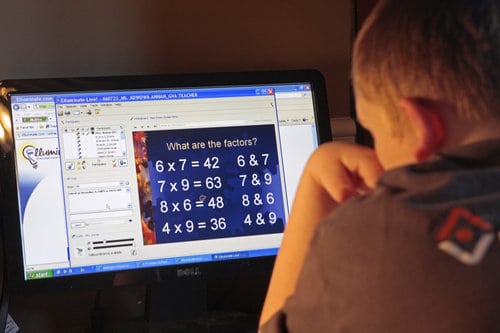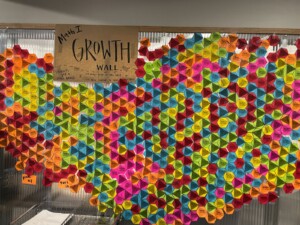Riverside Virtual School Takes a Competency-Based Approach to Online Curriculum

“In a reflective relationship between teacher and student, the teacher does not ask the student to accept the teacher’s authority; rather, the teacher asks the student to suspend belief in that authority, to join with the teacher in inquiry, into that which the student is experiencing. The teacher agrees to help the student understand the meaning of the advice given, to be readily confrontable by the student, and to work with the student in reflecting on the tacit understanding each has.” – A Pedagogic Creed by William E. Doll, Jr.
Online Learning Dance

Curriculum is personal. When created, teachers are essentially deciding what information is valuable enough to share with others. Will it challenge, engage, and inspire? Online curriculum allows for flexibility. One of the greatest things about online learning is that students work at their own pace, even with deadlines, the “when to work” is usually determined by the student. This is also one of the biggest challenges with online learning.
24/7 and 365 access means students are always working, even when teachers are not. Online and blended learning allows the teacher the opportunity to slow down and speed up based on individual student needs. Not all students need the same lesson on the same day. Creating, grading, and interacting with students in an online course is like a dance. You must know the steps, you must know your students, and you must have an idea of what the final product looks like. Then, you must embrace that, if done right, you are teaching more than dance steps, at any given moment the dance may change, and that you may learn a new dance in the process.
This summer, I started a dance. Colleague and History Department Chair David Dillon and I decided to mix things up at the Riverside Virtual School. It was time to align our disciplines and departments. We asked, how can we integrate our courses, allowing students to master standards for each, while learning Historical Literacy, and what it means to be a responsible digital citizen? How can we incorporate project-based and competency-based learning into our curriculum? How can we do this in a blended learning environment?
The first step was to decide to take the leap, and to start with middle school. This ongoing collaboration process is a powerful one, and reinforces the importance of working together on a meaningful project, both as a teacher, and as one that we want to emulate for our students. I am learning to teach differently. Technology is allowing me to do this.
Foundations and Explorations
“Coming together is a beginning, staying together is progress, and working together is success.” – Henry Ford
We looked at the standards for History and English Language Arts. How could we teach the students what they need to know, empower them to want to learn more, and incorporate a philosophy we both feel strongly about – a philosophy we call Foundations and Explorations?
We organize our courses by Foundations and Explorations. We create the projects first. We are still creating projects. We make changes all the time. Once we agree on a project (Exploration), we ask, what do students need to know how to do in order to be successful (Foundations)? We work backward. We created Foundations for all students, but quickly learned that some needed them more than others. That is okay.
If expectations are clear, and students know from the beginning that each step is purposefully placed to assist them in moving toward the projects, and why they are there, that is the main thing. Is it possible to cross the stream without stepping on each stone? Yes. Is it possible reach the other side by taking steps that are unique to us? Yes.
Roles of Teaching and Learning
Approaching curriculum this way allows the roles to shift. We are guiding our students. We are not simply telling them what to do and hoping that they make it. Flexibility is key. Communication is essential. We incorporate Understanding by Design into our teaching. According to the creators of the framework, “Effective curriculum development reflects a three-stage design process called “backward design” that delays the planning of classroom activities until goals have been clarified and assessments designed. This process helps to avoid the twin problems of “textbook coverage” and “activity-oriented” teaching, in which no clear priorities and purposes are apparent.” Grant Wiggins and Jay McTighe
Curriculum Based On Competency
One major challenge to teaching this way is that it takes longer. The curriculum becomes about competency rather than about pace and points. This is a yet another shift. William E. Doll, Jr. refers to a curriculum’s depth, to its layers of meaning, as Richness. He states that, “in order for students and teachers to transform and be transformed, a curriculum needs to have the “right amount” of indeterminacy, anomaly, inefficiency, chaos, disequilibrium, dissipation, lived experience.” I have had to come to terms with the idea that I cannot teach everything. It is overwhelming to try, yet, I have tried to teach each standard, each item on the pacing guide, and to administer each assessment “on time.” I am learning that in trying to cover everything, very little gets taught well.
Teach one dance at a time. Master the steps, gain confidence, create your style, and make it your own. If you get through fewer dances, that is okay, because the ones you do learn, you learn completely.






Melanie Vansell
Let me begin by saying that your article is (as they say in the UK) "Spot On!"
Educators are not machines. Students are not machines.
We need to be innovative and flexible in the field of education. Collaborating with colleagues and sharing successes will help guide students on a successful road to becoming productive members of society.
After all, isn't that what the goal of education should be?
Thank you again for your article.
Professor Melanie H. Vansell
Wes
Looking forward to seeing you present at ISTE!